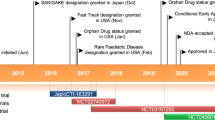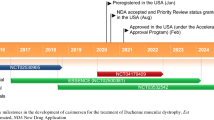Abstract
Viltolarsen is a phosphorodiamidate morpholino antisense oligonucleotide (PMO) designed to skip exon 53 of the DMD gene for the treatment of Duchenne muscular dystrophy (DMD), one of the most common lethal genetic disorders characterized by progressive degeneration of skeletal muscles and cardiomyopathy. It was developed by Nippon Shinyaku in collaboration with the National Center of Neurology and Psychiatry (NCNP) in Japan based on the preclinical studies conducted in the DMD dog model at the NCNP. After showing hopeful results in pre-clinical trials and several clinical trials across North America and Japan, it received US Food and Drug Administration (FDA) approval for DMD in 2020. Viltolarsen restores the reading frame of the DMD gene by skipping exon 53 and produces a truncated but functional form of dystrophin. It can treat approximately 8-10% of the DMD patient population. This paper aims to summarize the development of viltolarsen from preclinical trials to clinical trials to, finally, FDA approval, and discusses the challenges that come with fighting DMD using antisense therapy.
Access this chapter
Tax calculation will be finalised at checkout
Purchases are for personal use only
Similar content being viewed by others
References
Mendell JR, Shilling C, Leslie ND et al (2012) Evidence-based path to newborn screening for duchenne muscular dystrophy. Ann Neurol 71:304–313. https://doi.org/10.1002/ana.23528
Moser H (1984) Duchenne muscular dystrophy: pathogenetic aspects and genetic prevention. Hum Genet 66:17–40. https://doi.org/10.1007/BF00275183
Mercuri E, Muntoni F (2013) Muscular dystrophies. Lancet 381:845–860. https://doi.org/10.1016/S0140-6736(12)61897-2
Bushby K, Finkel R, Birnkrant DJ et al (2010) Diagnosis and management of Duchenne muscular dystrophy, part 1: diagnosis, and pharmacological and psychosocial management. Lancet Neurol 9:77–93. https://doi.org/10.1016/S1474-4422(09)70271-6
Manzur AY, Kinali M, Muntoni F (2008) Update on the management of Duchenne muscular dystrophy. Arch Dis Child 93:986–990. https://doi.org/10.1136/adc.2007.118141
Emery AE (2002) The muscular dystrophies. Lancet 359:687–695. https://doi.org/10.1016/S0140-6736(02)07815-7
Muntoni F, Torelli S, Ferlini A (2003) Dystrophin and mutations: one gene, several proteins, multiple phenotypes. Lancet Neurol 2:731–740. https://doi.org/10.1016/S1474-4422(03)00585-4
Koenig M, Hoffman EP, Bertelson CJ et al (1987) Complete cloning of the duchenne muscular dystrophy (DMD) cDNA and preliminary genomic organization of the DMD gene in normal and affected individuals. Cell 50:509–517. https://doi.org/10.1016/0092-8674(87)90504-6
Roberts RG, Coffey AJ, Bobrow M, Bentley DR (1993) Exon structure of the human dystrophin gene. Genomics 16:536–538. https://doi.org/10.1006/geno.1993.1225
Bladen CL, Salgado D, Monges S et al (2015) The TREAT-NMD DMD global database: analysis of more than 7,000 duchenne muscular dystrophy mutations. Hum Mutat 36:395–402. https://doi.org/10.1002/humu.22758
Carter JC, Sheehan DW, Prochoroff A, Birnkrant DJ (2018) Muscular dystrophies. Clin Chest Med 39:377–389. https://doi.org/10.1016/j.ccm.2018.01.004
Oudet C, Hanauer A, Clemens P et al (1992) Two hot spots of recombination in the DMD gene correlate with the deletion prone regions. Hum Mol Genet 1:599–603. https://doi.org/10.1093/hmg/1.8.599
Hoffman EP, Brown RH, Kunkel LM (1987) Dystrophin: the protein product of the duchenne muscular dystrophy locus. Cell 51:919–928. https://doi.org/10.1016/0092-8674(87)90579-4
Gao QQ, McNally EM (2015) The dystrophin complex: structure, function, and implications for therapy. Comprehensive Physiology, Wiley, pp 1223–1239
Ervasti JM (2007) Dystrophin, its interactions with other proteins, and implications for muscular dystrophy. Biochim Biophys Acta - Mol Basis Dis 1772:108–117. https://doi.org/10.1016/j.bbadis.2006.05.010
Nichols B, Takeda S, Yokota T (2015) Nonmechanical roles of dystrophin and associated proteins in exercise, neuromuscular junctions, and brains. Brain Sci 5:275–298. https://doi.org/10.3390/brainsci5030275
Ervasti JM, Campbell KP (1991) Membrane organization of the dystrophin-glycoprotein complex. Cell 66:1121–1131. https://doi.org/10.1016/0092-8674(91)90035-W
Yokota T, Lu Q, Partridge T et al (2009) Efficacy of systemic morpholino exon-skipping in duchenne dystrophy dogs. Ann Neurol 65:667–676. https://doi.org/10.1002/ana.21627
Lu QL, Mann CJ, Lou F et al (2003) Functional amounts of dystrophin produced by skipping the mutated exon in the mdx dystrophic mouse. Nat Med 9:1009–1014. https://doi.org/10.1038/nm897
Echigoya Y, Lim KRQ, Melo D et al (2019) Exons 45–55 skipping using mutation-tailored cocktails of antisense morpholinos in the DMD gene. Mol Ther 27:2005–2017. https://doi.org/10.1016/j.ymthe.2019.07.012
Koenig M, Beggs AH, Moyer M et al (1989) The molecular basis for duchenne versus becker muscular dystrophy: correlation of severity with type of deletion. Am J Hum Genet 45(4):498
Mendell JR, Rodino-Klapac LR, Sahenk Z et al (2013) Eteplirsen for the treatment of Duchenne muscular dystrophy. Ann Neurol. https://doi.org/10.1002/ana.23982
O’Keefe L (2020) FDA approves targeted treatment of rare Duchenne muscular dystrophy mutation. FDA news release
Aartsma-Rus A, Corey DR (2020) The 10th oligonucleotide therapy approved: golodirsen for duchenne muscular dystrophy. Nucleic Acid Ther 30:67–70. https://doi.org/10.1089/nat.2020.0845
Shirley M (2021) Casimersen: first approval. Drugs. https://doi.org/10.1007/s40265-021-01512-2
Bylo M, Farewell R, Coppenrath VA et al (2020) A review of deflazacort for patients with duchenne muscular dystrophy. Ann Pharmacother 54(8):788–794. https://doi.org/10.1177/1060028019900500
Moxley RT, Ashwal S, Pandya S et al (2005) Practice parameter: corticosteroid treatment of duchenne dystrophy: report of the quality standards subcommittee of the American academy of neurology and the practice committee of the child neurology society. Neurology 64(1):13–20. https://doi.org/10.1212/01.WNL.0000148485.00049.B7
Moxley RT, Pandya S, Ciafaloni E et al (2010) Change in natural history of duchenne muscular dystrophy with longterm corticosteroid treatment: implications for management. J Child Neurol 25(9):1116–1129. https://doi.org/10.1177/0883073810371004
Roshmi RR, Yokota T (2019) Viltolarsen for the treatment of Duchenne muscular dystrophy. Drugs Today 55:627. https://doi.org/10.1358/dot.2019.55.10.3045038
Dhillon S (2020) Viltolarsen: First Approval. Drugs 80:1027–1031. https://doi.org/10.1007/s40265-020-01339-3
Watanabe N, Nagata T, Satou Y et al (2018) NS-065/NCNP-01: an antisense oligonucleotide for potential treatment of exon 53 skipping in duchenne muscular dystrophy. Mol Ther Nucleic Acids 13:442–449. https://doi.org/10.1016/j.omtn.2018.09.017
Echevarría L, Aupy P, Goyenvalle A (2018) Exon-skipping advances for Duchenne muscular dystrophy. Hum Mol Genet 27:R163–R172. https://doi.org/10.1093/hmg/ddy171
Komaki H, Nagata T, Saito T et al (2018) Systemic administration of the antisense oligonucleotide NS-065/NCNP-01 for skipping of exon 53 in patients with Duchenne muscular dystrophy. Sci Transl Med 10:eaan0713. https://doi.org/10.1126/scitranslmed.aan0713
Yokota T, Lu Q, Partridge T et al (2009) Efficacy of systemic morpholino exon-skipping in duchenne dystrophy dogs. Ann Neurol 65(6):667–676. https://doi.org/10.1002/ana.21627
Inxight: drugs. In: U.S. Department of Health and Human Services. https://drugs.ncats.io/drug/SXA7YP6EKX
Dhillon S (2020) Viltolarsen: first approval. Drugs 80(10):1027–1031. https://doi.org/10.1007/s40265-01339-3
Pharma NS, Fda N, Dystrophy DM, et al (2020) NEWS RELEASE NS Pharma’s VILTEPSOTM (viltolarsen) injection Now FDA-approved in the U.S. for the treatment of duchenne muscular dystrophy in patients amenable to exon 53 skipping therapy. 1–4
Clemens PR, Rao VK, Connolly AM et al (2020) Safety, tolerability, and efficacy of viltolarsen in boys with duchenne muscular dystrophy amenable to exon 53 skipping. JAMA Neurol 77:982. https://doi.org/10.1001/jamaneurol.2020.1264
Komaki H, Takeshima Y, Matsumura T et al (2018) DMD CLINICAL THERAPIES II. Neuromuscul Disord 28:S68. https://doi.org/10.1016/j.nmd.2018.06.157
Komaki H, Takeshima Y, Matsumura T et al (2020) Viltolarsen in Japanese Duchenne muscular dystrophy patients: a phase 1/2 study. Ann Clin Transl Neurol 7:2393–2408. https://doi.org/10.1002/acn3.51235
Study to Assess the Efficacy and Safety of Viltolarsen in Ambulant Boys With DMD (RACER53), clinicaltrials.gov, ClinicalTrials.gov Identifier: NCT04060199 (2019)
(2020) Nippon Shinyaku Co. Ltd. Viltepso injection 250 mg: Japanese prescribing information. https://www.pmda.go.jp/
Clemens PR, Rao VK, Connolly AM (2018) A phase II, dose-finding study to assess the safety, tolerability, pharmacokinetics, and pharmacodynamics of NS-065/NCNP-01 in boys with Duchenne muscular dystrophy (DMD). 13th New Directions Biol Dis Skelet Muscle
Extension Study of NS-065/NCNP-01 in Boys With Duchenne Muscular Dystrophy (DMD). In: ClinicalTrials.gov. https://clinicaltrials.gov/ct2/show/record/NCT03167255
Rodrigues M, Yokota T (2018) An overview of recent advances and clinical applications of exon skipping and splice modulation for muscular dystrophy and various genetic diseases. pp 31–55
Himič V, Davies KE (2021) Evaluating the potential of novel genetic approaches for the treatment of Duchenne muscular dystrophy. Eur J Hum Genet. https://doi.org/10.1038/s41431-021-00811-2
Nakamura H, Kimura E, Mori-Yoshimura M et al (2013) Characteristics of Japanese Duchenne and Becker muscular dystrophy patients in a novel Japanese national registry of muscular dystrophy (Remudy). Orphanet J Rare Dis 8(1):60. https://doi.org/10.1186/1750-1172-8-60
Echigoya Y, Lim KRQ, Melo D et al (2019) Exons 45–55 skipping using mutation-tailored cocktails of antisense morpholinos in the DMD gene. Mol Ther 27(11):2005–2017. S1525001619303259. https://doi.org/10.1016/j.ymthe.2019.07.012
Lim KRQ, Woo S, Melo D et al (2022) Development of DG9 peptide-conjugated single- and multi-exon skipping therapies for the treatment of Duchenne muscular dystrophy. Proc Natl Acad Sci 119(9):e2112546119. https://doi.org/10.1073/pnas.2112546119
Meyers TA, Townsend D (2019) Cardiac pathophysiology and the future of cardiac therapies in duchenne muscular dystrophy. Int J Mol Sci 20(17):4098. https://doi.org/10.3390/ijms20174098
Echigoya Y, Nakamura A, Nagata T et al (2017) Effects of systemic multiexon skipping with peptide-conjugated morpholinos in the heart of a dog model of Duchenne muscular dystrophy. Proc Natl Acad Sci 114(16):4213–4218. https://doi.org/10.1073/pnas.1613203114
Jearawiriyapaisarn N, Moulton HM, Buckley B et al (2008) Sustained dystrophin expression induced by peptide-conjugated morpholino oligomers in the muscles of mdx mice. Mol Ther 16(9):1624–1629. S1525001616320615. https://doi.org/10.1038/mt.2008.120
Sheikh O, Yokota T (2022) Pharmacology and toxicology of eteplirsen and SRP-5051 for DMD exon 51 skipping: an update. Arch Toxicol 96(1):1–9. https://doi.org/10.1007/s00204-021-03184-z
Tyler KL (2003) Origins and early descriptions of ?Duchenne muscular dystrophy? Muscle Nerve 28:402–422. https://doi.org/10.1002/mus.10435
Lim KRQ, Echigoya Y, Nagata T et al (2019) Efficacy of multi-exon skipping treatment in duchenne muscular dystrophy dog model neonates. Mol Ther 27:76–86. https://doi.org/10.1016/j.ymthe.2018.10.011
Yin H, Moulton HM, Seow Y et al (2008) Cell-penetrating peptide-conjugated antisense oligonucleotides restore systemic muscle and cardiac dystrophin expression and function. Hum Mol Genet 17:3909–3918. https://doi.org/10.1093/hmg/ddn293
Yokota T, Nakamura A, Nagata T et al (2012) Extensive and prolonged restoration of dystrophin expression with vivo-morpholino-mediated multiple exon skipping in dystrophic dogs. Nucleic Acid Ther 22:306–315. https://doi.org/10.1089/nat.2012.0368
Min Y-L, Bassel-Duby R, Olson EN (2019) CRISPR correction of Duchenne muscular dystrophy. Annu Rev Med 70:239–255. https://doi.org/10.1146/annurev-med-081117-010451
Hakim CH, Wasala NB, Pan X et al (2017) A five-repeat micro-dystrophin gene ameliorated dystrophic phenotype in the severe DBA/2J-mdx model of Duchenne muscular dystrophy. Mol Ther Methods Clin Dev 6:216–230. https://doi.org/10.1016/j.omtm.2017.06.006
Author information
Authors and Affiliations
Corresponding author
Editor information
Editors and Affiliations
Rights and permissions
Copyright information
© 2023 The Author(s), under exclusive license to Springer Science+Business Media, LLC, part of Springer Nature
About this protocol
Cite this protocol
Roshmi, R.R., Yokota, T. (2023). Viltolarsen: From Preclinical Studies to FDA Approval. In: Maruyama, R., Yokota, T. (eds) Muscular Dystrophy Therapeutics. Methods in Molecular Biology, vol 2587. Humana, New York, NY. https://doi.org/10.1007/978-1-0716-2772-3_2
Download citation
DOI: https://doi.org/10.1007/978-1-0716-2772-3_2
Published:
Publisher Name: Humana, New York, NY
Print ISBN: 978-1-0716-2771-6
Online ISBN: 978-1-0716-2772-3
eBook Packages: Springer Protocols




